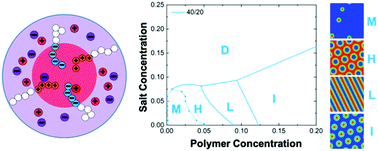Mapping the phase behavior of coacervate-driven self-assembly in diblock copolyelectrolytes
Abstract
Oppositely-charged polymers can undergo an associative phase separation process known as complex coacervation, which is driven by the electrostatic attraction between the two polymer species. This driving force for phase separation can be harnessed to drive self-assembly, via pairs of block copolyelectrolytes with opposite charge and thus favorable coulombic interactions. There are few predictions of coacervate self-assembly phase behavior due to the wide variety of molecular and environmental parameters, along with fundamental theoretical challenges. In this paper, we use recent advances in coacervate theory to predict the solution-phase assembly of diblock polyelectrolyte pairs for a number of molecular design parameters (charged block fraction, polymer length). Phase diagrams show that self-assembly occurs at high polymer, low salt concentrations for a range of charge block fractions. We show that we qualitatively obtain limiting results seen in the experimental literature, including the emergence of a high polymer-fraction reentrant transition that gives rise to a self-compatibilized homopolymer coacervate behavior at the limit of high charge block fraction. In intermediate charge block fractions, we draw an analogy between the role of salt concentration in coacervation-driven assembly and the role of temperature in χ-driven assembly. We also explore salt partitioning between microphase separated domains in block copolyelectrolytes, with parallels to homopolyelectrolyte coacervation.



 Please wait while we load your content...
Please wait while we load your content...